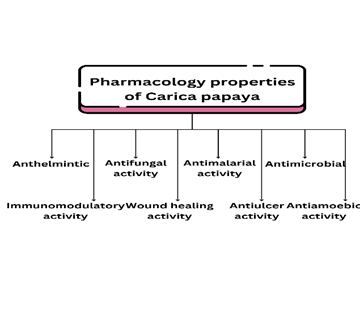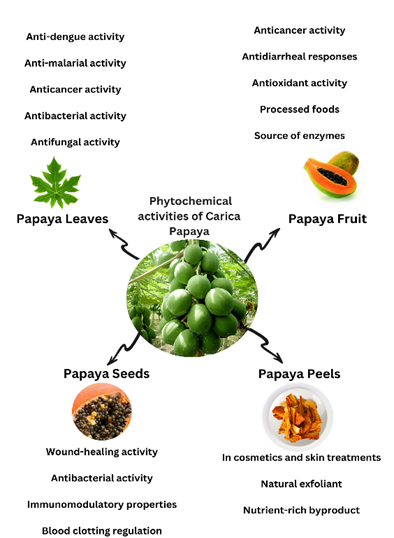Abstract
Parasitic infestations are an important cause of morbidity in children and are regarded as a serious public health hazard. Diseases generally caused by Ascaris Lumbricoides, Trichuris Trichura, and Hookworms have become a serious threat to the physical and cognitive development of children, particularly in areas lacking sanitation, hygiene, and ingestion of contaminated food and water. Parasites primarily cause diarrhea, abdominal pain, vomiting, lack of appetite, and abdominal distention; they can also cause iron deficiency anemia in pediatrics. Moreover giving medications to children can sometimes become a traumatic experience for the child and parents as they refuse to accept its taste and are already suffering from pain and discomfort. Recently there has been a growing interest in using plant constituents for drug development and treatments due to their natural medical properties. Studies suggest that papaya (Carica Papaya) seeds possess potent anthelmintic properties containing the primary compound Benzyl Isothiocyanate makes it a promising natural alternative for treating helminths. This research focuses on developing a child-friendly candy formulation incorporating C.papaya seed extract, rich in benzyl isothiocyanate offering an alternative drug delivery system aimed at medication compliance among pediatric patients. This research sheds important light on the possible applications of C. papaya seeds and a practical solution for treating children with helminth infection. This approach could improve deworming and is affordable and sustainable in resources-- limited settings
Keywords
Carica papaya, seeds extract, helminthiasis, anthelmintic Candies, bioactive compounds, natural alternatives, and parasitic infection.
Introduction
Helminthiasis, a condition caused by various parasitic worms, is a significant global public health concern, particularly in less-developed regions. These infections can result in severe health issues and even fatalities, particularly in vulnerable populations, such as young children and individuals with weakened immune systems [1][2][3]. The primary types of worms that commonly infect humans include roundworms (Ascaris lumbricoides), whipworms (Trichuris trichiura), and hookworms (Ancylostoma duodenale) [1]. Although conventional treatment methods typically involve pharmaceutical interventions, the rise of drug-resistant strains and their adverse effects have prompted the search for alternative treatment modalities. Research indicates that approximately 1 billion individuals are affected by Ascaris lumbricoides annually, with T. trichiura affecting 795 million and hookworms affecting 740 million people. an estimated 3.5 billion individuals worldwide are infected with intestinal parasites, with approximately 450 million children infected. [4]. Parasites can significantly affect an individual's health, manifesting as symptoms such as diarrhea, weight loss, abdominal pain, vomiting, nausea, reduced appetite, and abdominal bloating [5]. Additionally, parasitic infections may lead to iron-deficiency anemia, further complicating health [5]. Conventional treatment for soil-transmitted helminthiasis typically involves the use of benzimidazole drugs, including Albendazole and Mebendazole [4]. However, up to 80% of patients in developing countries face challenges in affording these conventional medications, prompting them to seek herbal or medicinal alternatives for relief. Access to affordable and effective health care remains a critical issue in many regions, driving individuals to explore alternative treatment options. Herbal remedies may offer some benefits; ensuring the safety, efficacy, and proper dosage of these alternatives is essential for the effective management of parasitic infections. Collaboration among healthcare providers, policymakers, and communities is crucial in addressing these healthcare disparities and promoting accessible treatment options for all individuals affected by parasitic diseases [4]. The issue of bitterness in solutions and suspensions is widely recognized in addressing the challenges presented by traditional oral medications for pediatric patients. Despite efforts to mask these flavors, unpleasant taste remains a significant hurdle in ensuring patient compliance and acceptance. Introducing innovative solutions such as Carica papaya seed-based candies presents a promising avenue for enhancing medication administration in children. The development of Carica papaya seed-based candies offers a unique opportunity, providing a novel and palatable alternative for pediatric patients [7]. The cost-effective nature of this product not only ensures affordability but also facilitates widespread availability in urban settings. By leveraging this innovative approach, healthcare providers can enhance patient experiences and ultimately improve medication adherence in the pediatric population. Exploring alternative formulations, such as Carica papaya seed-based candies, represents a valuable strategy to address the challenges associated with pediatric medication administration. Its potential impact in improving patient compliance and accessibility makes it a compelling option worthy of further consideration and development. Carica papaya (Linn), commonly known as papaya, is a fruit crop cultivated in tropical and subtropical regions and is valued for its nutritional and medicinal properties. Several studies have demonstrated the anthelmintic effects of Carica papaya seeds against gastrointestinal parasites [4]. Anthelmintic candies present a potentially innovative and agreeable method for treating parasitic worm infections, especially in regions where traditional medications may be inaccessible or challenging to administer [6][7]. The oral mucosa drug delivery approach has gained popularity, with medicated candies being a solid form that slowly dissolves on the tongue and is laced with medication on a sweet and flavored basis [7]. This approach aims to make the medication more enticing and easier to administer, especially for young patients who may struggle with the conventional forms. Papaya seeds contain a compound known as benzyl isothiocyanate (BITC) [7][8].
Plant Profile: Carica Papaya –
- Synonyms: Pawpaw, Tree melon, Papayotin, vegetable pepsin.
- Family: Caricaceae.
- Geographical source: The plant is cultivated in Sri Lanka, Tanzania, Hawaii, and Florida.
- Uses: Treating worms and parasites, anti-diabetic, anti-oxidant, and improves digestion.
Pharmacological Properties of C. Papaya:
- Anthelmintic -
Dried papaya seeds combined with honey can be an effective remedy for eliminating intestinal parasites in humans, with minimal side effects. The key active component in the seeds, benzyl isothiocyanate, has been shown to combat strong intestinal worms in mammals [9].
- Antimicrobial –
Extracts from papaya leaves and roots were evaluated for their effectiveness against various harmful bacteria. The findings indicated that the extracts were capable of eliminating some of these pathogenic bacteria [10].
- Anti-fungal activity-
The papaya latex when paired with medication fluconazole, can effectively inhibit the growth of fungus known as Candida albicans. This synergy leads to partial degradation of the cell wall. The latex derived from papaya plays a crucial role in achieving this effect and a minimum concentration of these proteins is required to achieve complete inhibition [11].
- Anti-malarial activity-
Extract from raw papaya fruit were evaluated for their effectiveness against malarial parasites. The result showed that these extracts were capable of killing the parasites at various concentration [12].
- Immuno-modulatory activity-
Researches conducted laboratory studies on papaya seed extract to examine its impact on the immune system. The findings indicated that it has the potential to stimulate specific white blood cells and enhance the production of substances that aid in combating infections and cancer [13].
- Anti-ulcer activity-
Researchers administered papaya seed extract to rats to investigate its potential to prevent alcohol-induced stomach damage. This effectively lowered stomach acid levels in the rat [14].
- Wound healing activity-
Researchers administered papaya fruit extract to diabetic rats to determine its potential to accelerate wound healing. The result suggests that C. papaya possesses significant wound-healing processes in rats [15].
- Anti-amoebic activity-
Papaya seed extract has been shown to effectively kill Entamoeba histolytica, the parasite responsible for amoebiasis [16].

Fig 1: Pharmacology properties of Carica papaya.
Chemical Constituents Of Papaya
Papaya is an extraordinary plant with numerous therapeutic benefits. Its various parts, including the leaves, fruit, seeds, root, bark, and latex, have long been used in traditional medicine for their healing properties
Table 1: Chemical composition of various parts of the papaya plant.[17]
|
Sr. No.
|
Part of the Plant
|
Constituents
|
|
1
|
Fruit
|
fat, fiber, carbohydrates, and minerals such as calcium, phosphorus, and iron. It also contains amino acids, vitamin C, carotene, thiamine, riboflavin, niacin, and malic acid (in green fruits). Additionally, it has volatile compounds like linalool and benzyl isothiocyanate, along with alkaloids such as ?-carpaine and glucosides like benzyl-?-D-glucoside and 4-hydroxyphenyl-2-ethyl-?-D-glucoside.
|
|
2
|
Juice
|
organic acids like n-butyric, n-hexanoic, and n-octanoic acids, as well as lipids including myristic, palmitic, stearic, linoleic, linolenic, vaccenic, and oleic acids.
|
|
3
|
Seeds
|
fatty acids, protein, and fiber. They also contain benzyl isothiocyanate, benzyl glucosinolate, glucotropaeolin, papaya oil, carpaine, and benzyl thiourea. Other components include ?-sitosterol, hentriacontane, caricin, and the enzyme myrosin.
|
|
4
|
Roots
|
arposide and the enzyme myrosin.
|
|
5
|
Leaves
|
vitamins C and E, choline, and alkaloids like carpaine, pseudocarpaine, and dehydrocarpaine I and II.
|
|
6
|
Bark
|
?-sitosterol, glucose, fructose, sucrose, galactose, and xylitol.
|
|
7
|
Latex
|
proteolytic enzymes such as papain, chymopapain (A, B, and C), peptidases (A and B), and lysozymes. It also contains glutamine cyclotransferase,
|

Fig 2: Phytochemical activities of Carica papaya
COMPARATIVE STUDIES:
This research investigated the anthelmintic effects of seeds from papaya and pumpkin. Pumpkin seeds, known for their high content of vitamin A, iron, phosphorus, and calcium, have been traditionally utilized for treating digestive and liver problems. Additionally, their oils have shown anthelmintic capabilities. Papaya seeds contain significant amounts of provitamin A, carotenoids, vitamin C, and dietary fiber, as well as benzyl isothiocyanate, which exhibits anthelmintic properties [17]. The study evaluated the anthelmintic efficacy of extracts from papaya and pumpkin seeds against earthworms. Researchers measured the duration required for the worms to become paralyzed and eventually die, testing various concentrations of both extracts. Results indicated that while both seed extracts demonstrated anthelmintic qualities, the papaya seed extract was slightly more potent. These findings suggest that seeds from both pumpkin and papaya could serve as potential natural sources of compounds for combating parasitic worms. [17].
Evaluation Parameters:
- Physical parameters –
In order to examine the surface properties and shape, ten candies are weighed and examined.
- pH Test-
the pH test is carried out by diluting 1 gram of hard candy with 10ml distilled water and then dipping it in a pH stick.
- Weight Variation Test –
20 candies were selected and weighed collectively and individually on an electronic balance. From the collective weight, the average weight is calculated. Each candy's weight is then compared with the average weight to ensure whether it is within permissible limits or not.
Average weight = weight of 20 candies/ 20
% Weight variation = average weight – the weight of each candy/ average weight*100
- Thickness test –
Using a vernier caliper, the dosage forms diameter thickness is measured. Each unit’s variation from the mean diameter is calculated and it should not be more than ± 5%.
- Hardness Test –
A Monsanto Hardness tester was used to determine the candy’s level of hardness.
- Moisture Content –
One gram is weighed using the gravimetric method and is kept in a desiccator for a full day. After deducting the final weight from the start, the moisture content difference is measured as
% Moisture content = Initial weight Final weight / Initial weight × 100
- In vitro mouth Dissolving Time –
Mouth dissolving time is determined by using a USP disintegration apparatus, where candies were placed in each tube of the apparatus and the time taken for the candies to dissolve completely is noted by using 100ml phosphate buffer of pH 6.8 at 37 degrees Celsius. This test is done in triplicate. The average dissolving time for candies is calculated and presented with standard deviation.
- Stability studies-
All the prepared formulations were subjected to stability studies at a temperature of 40 degrees Celsius / 75% RH for a period of 1 month. After 1 month drug content, weight variation, color, hardness, and moisture content were determined.
MATERIALS AND METHODS
Formulation Table:
|
Ingredients
|
Properties
|
|
Carica papaya extract
|
API
|
|
Glycerin
|
Lubricant, emollient.
|
|
Citric Acid
|
Preservative and flavoring agent.
|
|
Methyl Cellulose
|
Binder, coating agent.
|
|
Sucrose
|
Sweetener.
|
METHODOLOGY:
Extraction -
The seeds of Carica papaya were dried and coarse into a powder for extract preparation. The extract was prepared with the help of the soxhlets apparatus. An aqueous and alcoholic extract was prepared by dissolving 50mg of seed powder in it.Both extracts were concentrated in the evaporator and the residue is obtained was stored at a desirable temperature.[8]
Preparation Of Candy:

CONCLUSION:
Candies made from Carica papaya seed extract, which contains benzyl isothiocyanate, a compound known for its worm-fighting properties, offer a promising new way to treat helminth infections. Traditional treatments, like tablets or capsules, can be hard for kids to take, especially for those who have trouble swallowing or don’t like the bitter taste of medicine. Our research focuses on creating a more child-friendly solution by developing anthelmintic candies from papaya seed extract. These candies dissolve in the mouth, making them much easier for kids to take, especially those who have trouble with pills. This not only helps with compliance but also makes the treatment process smoother and more enjoyable for young patients.
REFERENCES
- World Health Organization. (n.d.). Helminthiasis. Retrieved October 22, 2024, from https://www.afro.who.int/health-topics/helminthiasis
- Asaolu SO, Ofoezie IE. The role of health education and sanitation in the control of helminth infections. Acta Trop. 2003 May;86(2-3):283-9.https://doi.org/10.1016/S0001-706X(03)00060-3
- Yasmeen, M., & Singh, S. (2015). Study of the prevalence of intestinal parasitic infection in children of Ghaziabad. Paripex Indian Journal Of Research.https://r.search.yahoo.com/
- Rijal, Komal. (2013). prevalence of intestinal parasitic infections among school children of Dadeldhura district of Nepal. JHAS. 3. 14-16. https://www.researchgate.net/publication/259463103_prevalence_of_intestinal_parasitic_infections_among_school_children_of_Dadeldhura_district_of_Nepal
- Evans, A. C., & Stephenson, L. S. (1995). Not by drugs alone: the fight against parasitic helminths. World health forum, 16(3), 258–261.https://pubmed.ncbi.nlm.nih.gov/7546164/
- Ming R, Hou S, Feng Y, Yu Q, Dionne-Laporte A, Saw JH, et al. (2008 Apr)The draft genome of the transgenic tropical fruit tree papaya (Carica papaya Linnaeus). Nature [Internet]. 1;452(7190):991–6.https://www.nature.com/articles/nature06856
- Garg, Akshat & Mandal, Suraj & Vishvakarma, Prabhakar. (2023). Exploring Carica Papaya Seeds Extract As A Herbal Jelly For Helminthiasis Treatment: A Comprehensive Analysis. World Journal Of Pharmacy And Pharmaceutical Sciences. 12. 763-775. 10.20959/wjpps20235-24744. https://www.researchgate.net/publication/371291485_Exploring_Carica_Papaya_Seeds_Extract_As_A_Herbal_Jelly_For_Helminthiasis_Treatment_A_Comprehensive_Analysis
- Patil, N., Jagtap, S., & Kadam, V. J. (2023). Design, Development and Evaluation of Anthelmintic Candy for Paediatric Use. International Journal of Pharmaceutical Research and Applications. (Masse, 01 jan 2023)[17] Holthaus, J., Lindbergh, C., & Malcolm, S. (2005). Trends in the Literature: A Review of Studies Using Content Analysis. CiteSeerX. https://citeseerx.ist.psu.edu/document?repid=rep1&type=pdf&doi=f612fc65090af181499b0a50bdc4dd236a2ed17d.
- Kermanshai, R., McCarry, B. E., Rosenfeld, J., Summers, P. S., Weretilnyk, E. A., & Sorger, G. J. (2001). Benzyl isothiocyanate is the chief or sole anthelmintic in papaya seed extracts. Phytochemistry, 57(3), 427–435. https://doi.org/10.1016/s0031-9422(01)00077-2https://pubmed.ncbi.nlm.nih.gov/11393524/
- Anibijuwon, I. I. and Udeze, A. O. (2009) "Antimicrobial Activity of Carica Papaya (Pawpaw Leaf) on Some Pathogenic Organisms of Clinical Origin from South-Western Nigeria," Ethnobotanical Leaflets: Vol. 2009: Iss. 7, Article 4.https://opensiuc.lib.siu.edu/ebl/vol2009/iss7/4/
- Giordani, R., Siepaio, M., Moulin-Traffort, J., & Régli, P. (1991). Antifungal action of Carica papaya latex: isolation of fungal cell wall hydrolysing enzymes. Mycoses, 34(11-12), 469–477. https://doi.org/10.1111/j.1439-0507.1991.tb00862.xhttps://pubmed.ncbi.nlm.nih.gov/1824416/
- Bhat, G. P., & Surolia, N. (2001). In vitro antimalarial activity of extracts of three plants used in the traditional medicine of India. The American journal of tropical medicine and hygiene, 65(4), 304–308. https://doi.org/10.4269/ajtmh.2001.65.304https://pubmed.ncbi.nlm.nih.gov/11693874/
- Rimbach, G., Park, Y. C., Guo, Q., Moini, H., Qureshi, N., Saliou, C., Takayama, K., Virgili, F., & Packer, L. (2000). Nitric oxide synthesis and TNF-alpha secretion in RAW 264.7 macrophages: mode of action of a fermented papaya preparation. Life sciences, 67(6), 679–694. https://doi.org/10.1016/s0024-3205(00)00664-0https://pubmed.ncbi.nlm.nih.gov/12659174/
- Abisola, N. O. T. (2012). Gastro-protective activity of aqueous Carica papaya seed extract on ethanol induced gastric ulcer in male rats. AFRICAN JOURNAL OF BIOTECHNOLOGY, 11(34). https://www.ajol.info/index.php/ajb/article/view/127612
- Wound healing activity of Carica papaya L. in experimentally induced diabetic rats. (2007, August 1). Retrieved https://pubmed.ncbi.nlm.nih.gov/17877152/
- Otsuki, N., Dang, N. H., Kumagai, E., Kondo, A., Iwata, S., & Morimoto, C. (2009). Aqueous extract of Carica papaya leaves exhibits anti-tumor activity and immunomodulatory effects. Journal of Ethnopharmacology, 127(3), 760–767. https://doi.org/10.1016/j.jep.2009.11.024
- Jyotsana Singh, Farha Shaikh, Rajvinder Kaur, Tripti, Kumkum, Ankita, Moni. Nutritional benefits of the Carica papaya: A review. Int J Herb Med 2023;11(6):10-14.
- Sengupta, R., & Banik, J. (2013). Comparative Studies on Anthelmintic Potential of Cucurbita Maxima (Pumpkin) Seeds and Carica Papaya (Papaya) Seeds. International Journal of Research in Ayurveda and Pharmacy, 4(4), 530–532.https://doi.org/10.7897/2277-4343.04415
- Blakemore, S. J., & Frith, C. D. (2003). Self-awareness and action. Current Opinion in Neurobiology, 13(2), 219-224. https://pubmed.ncbi.nlm.nih.gov/12659174/
- Olumide, O., & Ojo, A. (2015). Phytochemical properties and antimicrobial activities of crude extracts of Boerhavia diffusa and Ocimum gratissimum leaves. African Journal of Biotechnology, 14(36), 2709-2714. https://www.ajol.info/index.php/ajb/article/view/127612
- Blakemore, S. J., & Frith, C. D. (2003). Self-awareness and action. Current Opinion in Neurobiology, 13(2), 219-224. https://pubmed.ncbi.nlm.nih.gov/12659174/
- Lynn, D. J., & Collins, F. S. (2007). The Genomic Revolution: What Does It Mean for Clinical Medicine? Journal of Clinical Investigation, 117(11), 3155-3163. https://pubmed.ncbi.nlm.nih.gov/17877152/
- Kapur, S., & Seeman, P. (2001). Does fast dissociation from the dopamine D2 receptor explain the action of atypical antipsychotics? A new hypothesis. American Journal of Psychiatry, 158(3), 360-369. https://pubmed.ncbi.nlm.nih.gov/19961915/
- Centers for Disease Control and Prevention. (2021). About Soil-Transmitted Helminth Infections. Retrieved from https://www.cdc.gov/sth/about/?CDC_AAref_Val=https://www.cdc.gov/parasites/sth/
- Diomande, Masse., Beugré, Grah, Avit, Maxwell. (2023). Effects of Drying Temperature on the Physicochemical Characteristics and Functional Properties of Papaya Seeds (Carica papaya L.). International research journal of innovations in engineering and technology, 07(03):118-125.https://typeset.io/papers/effects-of-drying-temperature-on-the-physicochemical-3340gzmk
- Syanur, An-Nisa., Silma, Amalia, Putri., M., L., Affandi., Aulia, Rahmi, Pawestri. (2024). Promising Anthelmintic Properties of Papaya (Carica Papaya) Extract: A Literature Study. Jurnal Kedokteran Brawijaya.https://typeset.io/papers/promising-anthelmintic-properties-of-papaya-carica-papaya-3int2fvikp
- (2022). Anthelmintic Activity of Aqueous and Alcoholic Extracts of Carica papaya Seeds in Naturally Infested Goats. Journal of Dairying, Foods & Home Sciences.https://typeset.io/papers/anthelmintic-activity-of-aqueous-and-alcoholic-extracts-of-aahj33qw
- Sacks, L. V., & Walsh, T. J. (2001). Life-threatening sepsis due to a viridans streptococcus resistant to penicillin in a patient with acute myelogenous leukemia. Phytochemistry, 58(4), 541-548. https://doi.org/10.1016/S0031-9422(01)00077-2
- Adiaha, Monday & Adiaha, Magdalene Sunday. (2021). Effect of Nutritional, Medicinal and Pharmacological Properties of Papaya (Carica papaya Linn.) to Human Development: A Review.https://www.researchgate.net/publication/351765353_Effect_of_Nutritional_Medicinal_and_Pharmacological_Properties_of_Papaya_Carica_papaya_Linn_to_Human_Development_A_Review
- Oladokun, Abdullah & Effendy, A. & Suparjo, N. & Ameen, Saliu. (2014). Evaluation of Anthhelmintic Potential of Pawpaw (Carica papaya) Seeds Administered In-Feed and In-Water for West African Dwarf (WAD) Goats. IISTE (journal of bilogy, agriculture and health care). Vol.4.https://www.researchgate.net/publication/264497095_Evaluation_of_Anthhelmintic_Potential_of_Pawpaw_Carica_papaya_Seeds_Administered_In-Feed_and_In-Water_for_West_African_Dwarf_WAD_Goats
- Okeniyi, John & Ogunlesi, Tinuade & Oyelami, Oyeku & Adeyemi, Lateef. (2007). Effectiveness of Dried Carica papaya Seeds Against Human Intestinal Parasitosis: A Pilot Study. Journal of medicinal food. 10. 194-6. 10.1089/jmf.2005.065. https://www.researchgate.net/publication/6358582_Effectiveness_of_Dried_Carica_papaya_Seeds_Against_Human_Intestinal_Parasitosis_A_Pilot_Study
- Anamika & Chandra, Geetika. (2024). A Brief Review Article on Carica papaya and its Medical Advantages. Research Journal of Pharmacognosy and Phytochemistry. 16. 180-184. 10.52711/0975-4385.2024.00034. https://www.researchgate.net/publication/382870978_A_Brief_Review_Article_on_Carica_papaya_and_its_Medical_Advantages
- Pattiyappan, Sagadevan & Sakthivel, Selvakumar & Murugesan, Raghunath. (2019). Medicinal properties of Carica papaya Linn: Review. Madridge. 120-125. https://www.researchgate.net/publication/335990846_Medicinal_properties_of_Carica_papaya_Linn_Review_Madridge.


 Sayed Nazira *
Sayed Nazira *
 Qureshi Mohammad Kaif
Qureshi Mohammad Kaif
 Ayesha Choudhary
Ayesha Choudhary
 Sayed Rahebar
Sayed Rahebar
 Raashi Sayed
Raashi Sayed
 Foorkan Fakki
Foorkan Fakki



 10.5281/zenodo.14756487
10.5281/zenodo.14756487